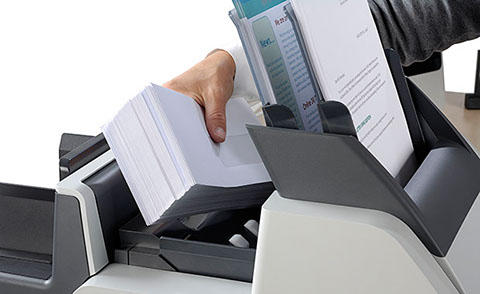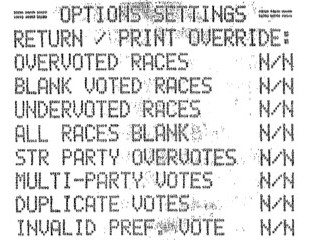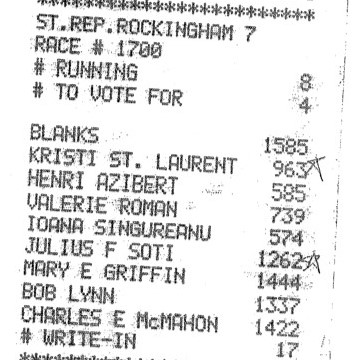New Hampshire Election Audit, part 2
Freedom to Tinker 2021-06-07
In my previous post I explained the preliminary conclusions from the three experts engaged by New Hampshire to examine an election anomaly in the town of Windham, November 2020. Improperly folded ballots (which shouldn’t have happened) had folds that were interpreted as votes (which also shouldn’t have happened) and this wasn’t noticed by any routine procedures (where either overvote rejection or RLAs would have caught and corrected the problem)–except that one candidate happened to ask for a recount. At least in New Hampshire it’s easy to ask for a recount and the Secretary of State’s office has lots of experience doing recounts.
Let’s consider these issues one at a time.
Ballot folds interpreted as marks
National standards for voting machines say that creases should not be interpreted as votes. The “Voluntary Voting System Standards”, version 1.0 from 2005 and version 2.0 from 2021, say this:
1.1.6-I – Ignore extraneous marks inside voting targets. The voting system must include a capability to recognize any imperfections in the ballot stock, folds, and similar insignificant marks appearing inside the voting targets and not record them as votes.
But Windham, New Hampshire bought its AccuVote OS machines in 1998, so let’s look at the 1990 Federal Election Commission standards:
Reading Accuracy: This … Subsystem attribute refers to the inherent capability of the read heads to … discriminate between valid … marks and extraneous perforations, smudges, and folds.
Although New Hampshire does not consider itself bound by these “voluntary” standards, certainly the AccuVote OS was sold in states that asked for test reports against those 1990 standards. So presumably the AccuVote OS, when new and when properly calibrated, was supposed to ignore fold lines. However, it appears testing agencies don’t actually test for this, even if the standards call for it.
It is not clear whether these machines have been recalibrated to different settings than the manufacturer preset–sometimes there are reasons for doing that. And the careful testing by the New Hampshire audit team makes it clear that the AccuVote OS does not always ignore fold lines.
Fold lines through vote targets
Even though voting machines are not supposed to interpret creases as votes, experienced election administrators know that they should keep the fold lines away from the vote targets (ovals that the voter fills in).
Most ballots are printed by private companies that contract with local election officials. In western states, where many millions of voters routinely vote by mail, election administrators contract with their printers not only to print the ballots, but to fold them and insert them in envelopes as well, and often also to bulk-mail them directly to the voters. Those printing companies get trained (either by the election officials, or by the major voting machine companies) about how to set up their high-speed automatic equipment to fold the ballots, avoiding vote targets.
But in some eastern states where there have been relatively few absentee ballots, local election officials often mail out the ballots themselves. In 2020, as in previous years, the State of New Hampshire contracted with a printing company to print their ballots. The printer printed the absentee ballots with score lines, that is, indentations in the paper that show where it should be folded–so when you fold by hand, it ought to fold at the scores. And indeed, these score lines were indented in the right place, avoiding the vote targets. If only the ballots had been folded at the score lines, there would have been no problem.
Jennifer Morrell, who was a local election official in Utah and Colorado, writes,
We always worked with our mail ballot printing vendor to ensure the pre-scored fold lines did not hit a target area on the ballot. It was a bit tedious because we had 600+ ballot styles but I don’t recall it ever being a problem. My recollection is that they were always able to find a single position for each fold mark (generally just two folds so the ballot was folded in thirds) that worked with all styles. One year was challenging because our ballot was so long we had three fold marks (ballot folded in half and then in half again) which put one of them squarely in the middle of the ballot. For flat ballots voted in-person at polling locations, we printed those “on demand” and purchased pre-scored ballot stock from the vendor (with the folds in the same position as they were on the mail ballots). This mitigated (but not alleviated completely) the risk of voters folding the ballots in a way that would create a problem. Mainly, if they folded a ballot that was not scored, there was a potential for the fold to damage the timing mark causing the ballot to be rejected by the scanning equipment as unreadable. Which then means it would need to be sent for duplication/remake.
In previous years, there weren’t many absentee ballots to be mailed out, so Windham employees would fold the (prescored) ballots by hand, put them in envelopes, and mail them. Likely enough, the creases would usually be on the score lines, avoiding the vote targets. But in 2020, during the pandemic, thousands of voters requested absentee ballots. The town improvised: they used a folder/inserter machine (normally used for DMV notices) to fold the ballots; then they “ironed” the folds with a coin or scissors-handle to make them fit in their envelopes.
 MailMax Solutions DS-35 folder/inserter
MailMax Solutions DS-35 folder/inserterThis machine is probably wonderful for its intended purpose–folding business letters, electricity bills, DMV notices, etc. before mailing to customers. But it does not put creases in exactly the right places for ballots; either because it had not been adjusted for that, or because it does not put creases straight across (they’re slightly diagonal), or because even when adjusted it doesn’t always put the crease in exactly the same place.
In particular, the absentee ballots folded by the DS-35 were not folded at the score lines; many of them were folded through the vote target for Democratic candidate Kristi St. Laurent.
WINDHAM!
— Heather Mullins – Real America’s Voice (RAV-TV) (@TalkMullins) May 24, 2021Got an up close look at an official Nov 3rd ballot thanks to @WAuditors. The diagonal fold line goes through Kristi St. Laurent’s bubble on the ballot. Those folds, as demonstrated by the test scans done last week, often got mistakenly counted as votes. @RealAmVoice pic.twitter.com/ItVgH2rkUT
Dust and calibration
The fold line went through a vote target–but isn’t the voting machine supposed to ignore that? In principle, yes. But these creases are substantial ridges! Windham was using four AccuVote optical scanners on November 3rd, and the auditors found that some of these machines were much more likely than others to interpret folds as votes. The auditors also found that there was a substantial build-up of dust on the read heads of the scanners; and that these read heads were enclosed in such a way that it would be difficult to get in there and clean them, or even to notice that there was a dust build-up. And they found “dust is a major contributor to reading errors of folds;” cleaning out the dust reduced the error rate.
One can imagine different hypotheses for why dust could increase the sensitivity to fold marks. Perhaps dust on the read head blurs the image, making the fold appear wider. Perhaps dust reduces sensitivity overall, so that as dust built up over the years the technicians recalibrated the machine to increase its sensitivity (so that legitimate votes were not missed).
Could this be happening elsewhere?
Should we be worried that election results are wrong in other jurisdictions that use AccuVote optical scanners–or any kind of optical scanners? Let’s see what chain of circumstances caused this problem:
- Ballots were folded improperly, in part because the COVID-19 pandemic caused a last-minute surge in absentee voters and the town had an unforeseen need to fold 3000 ballots. (In other times and places, jurisdictions that mail out thousands of folded ballots usually have them folded by printing companies that are experienced in the special requirements for ballots.)
- The fold line, as produced by the automatic folding machine, happened to fall upon a vote target.
- The AccuVote scanners had not been cleaned of a (perhaps years-long) dust buildup. Do election administrators in other places clean the read heads of their optical scanners? Are other models of voting machine susceptible to this problem?
- Windham had disabled overvote notification on these scanners (following State policy). That is, reading the fold as a vote caused (in hundreds of cases) more votes to be cast in this contest than allowed, so the machine noticed an overvote and didn’t count any of the votes in that contest (on that ballot). If the machine were set to reject overvoted ballots on the spot, in the presence of the voter, that gives the voter a chance to get a fresh ballot and try again. You might think that doesn’t seem apply to absentee ballots; but in fact it can: there was a poll worker feeding those absentee ballots through the scanner, and overvote rejection would give the poll worker a chance to place overvoted ballots into a separate pile for hand counting. It’s a best practice, followed in many other jurisdictions, that all overvoted ballots are segregated for manual interpretation.
 Results-report printout from Windham, November 3 2020, showing that overvote-return feature on AccuVote OS was disabled.
Results-report printout from Windham, November 3 2020, showing that overvote-return feature on AccuVote OS was disabled.- Windham had ignored overvote reporting. At the close of the polls, the AccuVote OS prints out a cash-register tape with results. The overvotes are reported as BLANKS (which also includes ballots in which the voter didn’t vote at all in this contest). It would have been better if the voting machine reported OVERVOTES separately from true BLANKS. But even so, the extremely high number of blanks could have been a warning sign to investigate further, by a hand recount (without waiting for a candidate to request it)–except that such a recount would not have been legal under State law.

- New Hampshire does not have Risk-Limiting Audits. An RLA examines a random sample of the paper ballots, sampling just enough ballots to ensure that the outcome claimed by the voting machine is the same as you’d get by recounting the paper ballots by hand. One motivation of RLAs is to catch hacking, but they work just as well to catch any kind of systematic error. If New Hampshire had RLAs, then any problem like this that could have changed the outcome of an election would probably have been detected–and corrected by a recount.
Could folds have changed votes elsewhere in New Hampshire? Possibly. Did other towns use nonstandard equipment to fold their absentee ballots? The town clerks might know. And if so, which vote target (if any) would the fold line have fallen upon? Unknown. Do other towns have AccuVote OS machines that have not been cleaned for 22 years? Probably. Do other towns disable overvote rejection? Almost certainly. Do other towns ignore high numbers of BLANKS on results printouts? Probably. Do other towns do Risk-Limiting Audits that would have caught this? No, state law prohibits that.
Recommendations
Optical-scan voting can be extremely accurate when best practices are followed. New Hampshire should adopt these practices immediately:
- Enable overvote rejection on the AccuVote OS. That means, the voting machine returns the overvoted ballot to the voter or pollworker for correction. When the voter is not present (as for an absentee ballot) the overvoted ballot should be segregated for manual counting, because often a human can readily determine the voter’s intent. When the voter is present, the voter can be given the choice of either voiding their ballot and casting a new one, or having their ballot segregated for manual counting.
- Clean the read heads of all their optical-scan voting machines as often as necessary, which might be every year or every four years, to be determined. This will require some disassembly of the machines.
- Set the voting machines to report (in each contest) the number of overvotes separately from the number of blanks. In principle there should be few reported overvotes if recommendation #1 is followed. Even so: if the number of overvotes is more than half the margin of victory in any race, examine all overvoted ballots; or if overvoted ballots cannot be segregated, recount the whole contest.
- Have absentee ballots folded automatically by the election-services contractor, rather than folded ad-hoc in town offices. Town Clerks should inspect a sample of absentee ballots before they are mailed to make sure the folds avoid all vote targets. If absentee ballots are mailed directly to voters by the services company, then Town Clerks should inspect a sample of the returned absentee ballots to make sure the folds are in the right place. (If not, count those ballots by hand.)
- Determine whether the procedures and software used for the layout of optical-scan ballots properly keep all vote targets away from any portion of the paper where folds might be made. (See “lesson” below.)
- Adopt Risk-Limiting Audits statewide. All the recommendations 1-5 above are reactive to the specific unforeseen problem that occurred last time. But what different problem will come up next time? The purpose of mandatory, every-election RLAs is to detect any kind of problem that might cause machine-reported results to be different from what you’d get in a correct manual recount. And these mandatory RLAs should be done before results are certified, so that if the RLA does detect a problem, then it can be immediately corrected by a recount. And one thing we learned from this is that the Secretary of State’s office can do recounts accurately.
Lessons for voting machine design
Humans have no difficulty understanding that a fold line is not a vote; we don’t look only within the oval, but at a more holistic context. One might think that modern algorithms, running on the more powerful CPUs that voting-machine makers put in their contemporary products, might interpret marks much more accurately than the AccuVote OS from the 1990s. I haven’t seen any evidence of this, one way or the other. It might be worth subjecting newer products to independent testing; or doing research on vote-mark recognition algorithms, or both.
Furthermore, there are good standards for the design of ballots so that voters are less likely to make mistakes: Effective Designs for the Administration of Federal Elections, Section 3: Optical scan ballots. But that guide says nothing about absentee ballots; the only instructions it gives are “do not fold the ballot”, which is not useful advice for mail-in ballots. Updated design guidelines would be useful, saying vote targets shoud not be placed anywhere near the point in the paper were the fold will most naturally go.
Ballot-layout software should be improved to take fold-line positions into account when placing vote targets. As it is now, it seems that the targets go where they go, and then the election administrator and printing company have to scramble to find a place where the fold can go.
Finally, even though the Federal standards require optical-scan voting machines to ignore fold marks, it appears that this is not tested in the “certification test plan” for a voting machine like the AccuVote OS. If the standards say that voting machine should ignore folds, then that should be tested for.